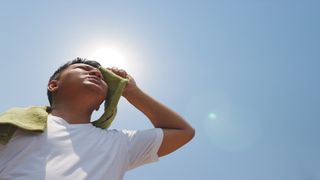For the first time, scientists have named a heat wave
A heat wave in Spain gets a name like a hurricane.

For the first time, scientists have named a heat wave. They called it Zoe.
According to USA Today, the Spanish scientists bestowed the moniker on a heat wave that sent temperatures soaring to 112 degrees Fahrenheit (44.4 degrees Celsius) in Seville between July 24 and July 27. It's a new effort to alert the public to extreme temperatures and warn them of the dangers, José María Martín Olalla, an associate professor in the department of condensed matter physics at Sevilla University, told the newspaper.
Hurricanes have long received human names, and an unofficial practice of giving winter storms nicknames emerged in2012 in the United States. But Zoe is the first heat wave to be given a name. The name is an effort of the proMETEO Sevilla Project, an initiative of the Adrienne Arsht-Rockefeller Foundation Resilience Center of the Atlantic Council, a Washington-based research center and non-profit organization. Seville is the pilot location for the project, which aims to raise public awareness of extreme heat and to advocate for efforts to reduce the dangers of heat waves.
Related: How heat waves kill so quickly
Heat waves aren't just toasty days. They're defined by the Spanish State Meteorological Agency (AEMET) as episodes of at least three consecutive days during which a minimum of 10% of weather stations record maximum temperatures above the 95th percentile for July to August between 1971 to 2000. There is no single definition of a heat wave in the United States, but the Environmental Protection Agency (EPA) uses a benchmark of at least two days when the daily minimum temperature, adjusted for humidity, is greater than the 85th percentile for July and August between 1981 and 2010.
Heat waves can be dangerous, especially for vulnerable populations like older individuals and people who do manual labor outdoors. The World Health Organization calculated in 2018 that between 2000 and 2016, the number of people exposed to extreme heat each year increased by 125 million. In July, temperatures in England exceeded 104 degrees F (40 degrees C) for the first time on record. This level of heat can be deadly, particularly in regions that lack air conditioning or buildings constructed to cope with high temperatures.
The United States is also experiencing periods of extreme heat as the climate changes. Today (Aug. 15), the nonprofit First Street Foundation released a report highlighting where extreme heat is likely to become more common in future decades. Their modeling suggests that the Deep South, southern Arizona and southern to central California will experience some of the most extreme shifts. For example, Miami-Dade County in Florida will likely experience 34 days above 103 degrees F (39.4 degrees C) by 2053, compared with seven today.
Sign up for the Live Science daily newsletter now
Get the world’s most fascinating discoveries delivered straight to your inbox.
Related: What are the effects of global warming?
While 8 million people in the United States this year will experience a heat index above 125 degrees F (51.6 degrees C), a staggering 107 million are expected to experience those temperatures by 2053, the nonprofit found. (Heat index takes into account humidity to adjust how a given air temperature feels to the human body. The higher the humidity, the warmer a given air temperature will feel.)
Zoe may be the first named heat wave, but it won't be the last. Authorities in Spain plan to alternate female and male names in reverse alphabetical order for future heat events. By naming heat waves, proMETEO Sevilla hopes to let the public know that they'll need to take extra care, USA Today reported. In a heat wave, the WHO advises keeping cool by opening windows at night to let cooler air in and keeping light out during the day. Special care should be taken to ensure that infants, people over the age of 60, or those with chronic health conditions be kept cool.
Originally published on Live Science.

Stephanie Pappas is a contributing writer for Live Science, covering topics ranging from geoscience to archaeology to the human brain and behavior. She was previously a senior writer for Live Science but is now a freelancer based in Denver, Colorado, and regularly contributes to Scientific American and The Monitor, the monthly magazine of the American Psychological Association. Stephanie received a bachelor's degree in psychology from the University of South Carolina and a graduate certificate in science communication from the University of California, Santa Cruz.
Most Popular

